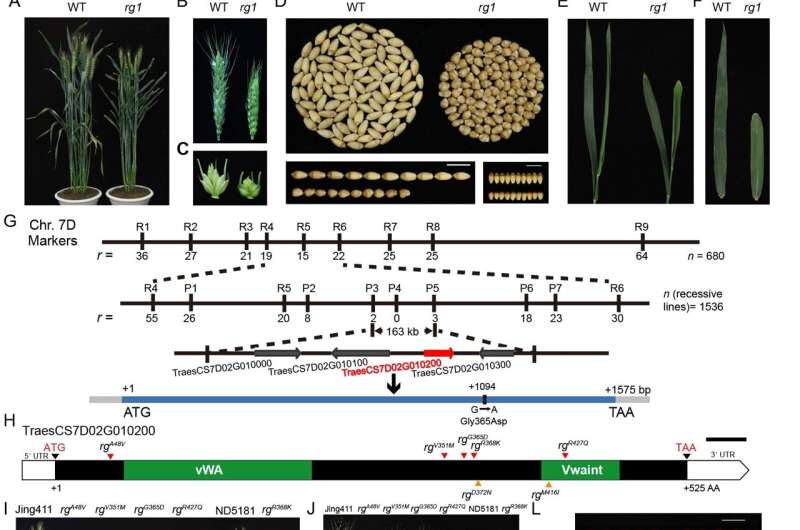This article has been reviewed according to Science X's editorial process and policies. Editors have highlighted the following attributes while ensuring the content's credibility:
fact-checked
peer-reviewed publication
trusted source
proofread
Identification of a von Willebrand factor type A protein affecting both grain and flag leaf morphologies in wheat

Wheat production is essential for global food security, and continual improvement to grain yield is necessary to meet the nutritional demands of the expanding human population. Grain size is positively correlated with grain weight, while the flag leaf serves as the major source of photosynthetic assimilates for grain development, therefore grain and flag leaf morphologies are determining factors in the final yield potential of wheat. Identification of genes involved in both grain and flag leaf morphologies remains an essential step in precision breeding and cultivation of wheat with high yield potential.
Chunyun Zhou, Hongchun Xiong, and their colleagues in Luxiang Liu's group from the Institute of Crop Sciences, Chinese Academy of Agricultural Science, identified a von Willebrand factor type A (vWA)-/Vwaint domain-containing protein, which affects grain size and flag leaf morphology, by map-based cloning from a round grain 1 (rg1) wheat mutant, and they revealed the molecular mechanism of phenotypic variations in the mutants. The work is published in the journal Science China Life Sciences.
The team identified a round grain (rg1) mutant with shorter flag leaf and plant height from the background of winter wheat variety Zhongmai 175, and fine mapped the rg1 gene to a 163 kb physical interval on chromosome 7D. Gene sequencing analysis indicated that the TraesCS7D02G010200 encoding a vWA and Vwaint domain-containing protein was the candidate gene of RG1. Missense mutations in seven round grain/short flag leaf mutants from backgrounds of Jing411 and Nongda5181 supported that TraesCS7D02G010200 was the causal gene for altered grain size and flag leaf morphology.
Further protein structural modeling indicated that amino acid substitutions located at the critical sites for protein folding, especially in the highly conserved Vwaint domain, resulted in the round grain/short flag leaf phenotype. Further analyses on protein interaction and hormone content suggest that RG1 may regulate GA and ABA levels via interaction with the isoprenoid synthesis protein, MCT, which could contribute to reduced grain size and flag leaf length.
Additionally, natural variation populations were also used to identify haplotypes that are associated with varying grain size-related traits.
This study reveals the functions of vWA domain in the regulation of grain size and flag leaf morphology. It provides a theoretical basis and genetic resources including RG1 haplotypes that can facilitate improvement of grain size and weight in wheat and potentially other cereal crops.
More information: Chunyun Zhou et al, Identification of a von Willebrand factor type A protein affecting both grain and flag leaf morphologies in wheat, Science China Life Sciences (2024). DOI: 10.1007/s11427-024-2629-1
Journal information: Science China Life Sciences
Provided by Science China Press





















